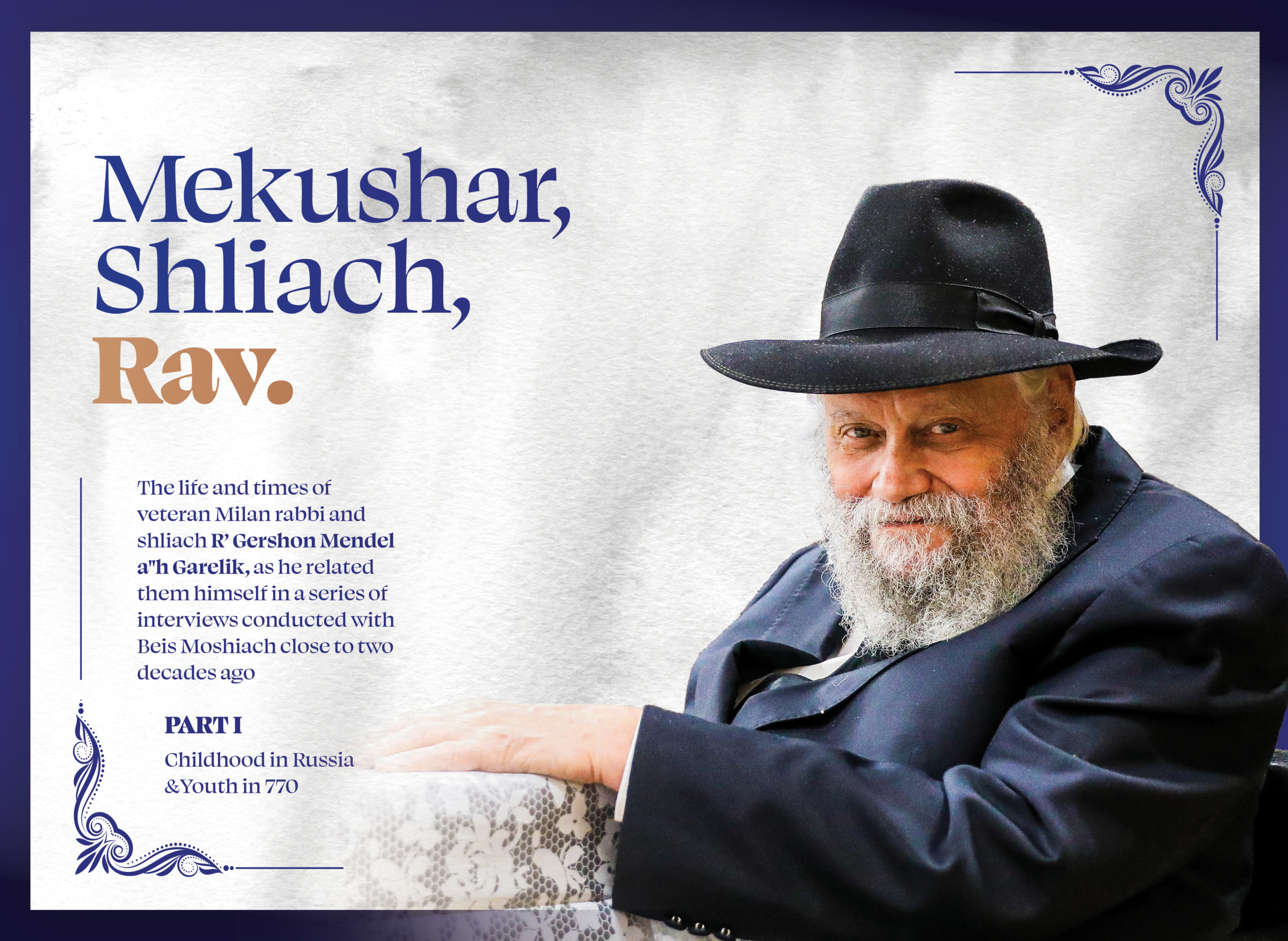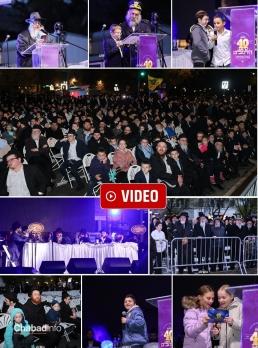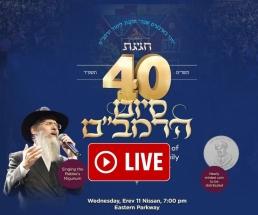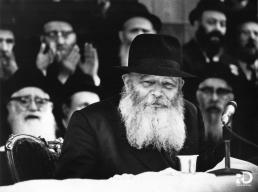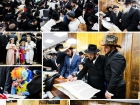Rabbi Gershon Mendel Garelik A”H: Mekushar, Shliach, Rav.
The life and times of veteran Milan’s rabbi and shliach Rabbi Gershon Mendel Garelik A”H, as he related them himself in a series of interviews conducted with Beis Moshiach close to two decades ago Part I Childhood in Russia & Youth in 770 • Presented in honor of his second yahrzeit on Rosh Chodesh Adar • Full Article
Avrohom Rainitz, Beis Moshiach
“Mine is a powerful longing to see the face of my spiritual father, the Rebbe shlita of Lubavitch, who raised me with the words of his mouth and his directives.”
These deeply emotional words were written by the shliach, Rabbi Gershon Mendel Garelik a’h, in a letter that he sent to Israeli President Yitzchok Ben-Tzvi, asking him to exert pressure on the Defense Ministry to enable him to leave the country and go to the Rebbe. He ended this letter with, “I assume that the honorable president will understand me well, my powerful and vigorous longing to see the one who saved me from descending to the abyss and placed me in the corner of light of Torah and Chassidus … and will respond to my request which comes from the depths of my overwrought heart and that you will give your positive recommendation to arrange the matter so that I can make this trip to the Rebbe, my savior and deliverer.”
These words, written in R’ Garelik’s youth, express his strong connection to the Rebbe out of a burning love and absolute bittul. As water reflects a face, the Rebbe treated him with a rare, fatherly love.
For many years, R’ Garelik refrained from telling about the special kiruvim he regularly merited from the Rebbe, until the series of interviews that he gave to Rabbi Shneur Zalman Hertzel, editor of HaTomim, a supplement to Beis Moshiach meant for the tmimim.
R’ Garelik, who recently passed away at the age of 88, was a colorful individual because of his style and personality and because of the kiruvim he received that were so fatherly in nature. These days, as we grasp every story, hanhaga or kiruv from the Rebbe, we present stories and anecdotes interwoven into his life’s story.
1 – SILENCE IN THE NKVD INTERROGATION ROOM
R’ Gershon Mendel was born on 8 Iyar 5692/1932 in the Soviet Union. His parents were Rabbi and Mrs. Chaim Meir and Rivka Leah Garelik. In his childhood, he attended underground yeshivos founded by Chabad Chassidim and even had the “opportunity” to be arrested by the Soviet police as he once told Rabbi Aryeh Goldberg, chairman of the Merkaz Rabbanei Europa:
“To make a living without desecrating the Shabbos, my mother knitted socks at home and would sometimes send me to the black market to exchange them for food. One day, I was caught by the NKVD who took me for an interrogation in their offices to find out who gave me the merchandise. They placed me on a three-legged chair so I would have to maintain my balance or fall. For four and a half hours they shot questions at me and I remained silent. I did not utter a word. I knew that my mother’s life depended on my silence.
“As the interrogation continued, a Jew arrived who had connections with the authorities. He saw me, realized I had been caught, and began to think of how to get me freed. He went over to the interrogators and asked them about me. They answered, in obvious frustration, that they had been spending hours trying to find out who I am and what I was doing but I did not say anything. ‘He is the town idiot,’ said the Jew.
“Hearing this, the interrogators threw me out with a painful kick. I learned a lesson for life, not to speak a lot. If I don’t have to speak, silence is preferable.”
Anyone who attended R’ Garelik’s farbrengens surely remembers the moments of silence which were more plentiful than the moments of speech when, every so often, he would rouse himself from his silence, sigh and say from the depths of his heart, “Ach … We have a Rebbe; it is so good.”
2 – THE REBBE’S FAMILY
When he was a child, R’ Garelik’s family moved to Almaty where the Rebbe’s parents, Rabbi Levi Yitzchok and Rebbetzin Chana Schneerson were. When the Gareliks left Russia, in the great escape of Chabad Chassidim from Russia in 1946, a special closeness developed between the Gareliks and Rebbetzin Chana.
While in the DP camp in Poking, young Gershon Mendel went to the forest to cut wood to light the oven in Rebbetzin Chana’s barrack. One winter day, when all the trees were damp and it wasn’t possible to obtain dry wood, he and his friend Leibel Raskin managed to get into a house in the middle of the forest that had been used by the Germans and they took wood from there.
When he arrived at the Rebbe for the first time, Rebbetzin Chana heard about it and called for him. A few days after his arrival, he visited her and after that he visited her home many more times. The Rebbetzin felt very affectionately toward him to the point that she once even said that she relates to him like her own son.
As much as we can interpret what the Rebbe does, perhaps we can say that this connection with his mother is one of the reasons for the special treatment R’ Garelik received from him over the years, for they were sort of like “brothers.”
3 – RESCUING YEMENITE CHILDREN
Shortly after they left Russia, the Gareliks moved to Eretz Yisrael and were among the first settlers in Kfar Chabad. In the early fifties Gershon Mendel learned in Yeshivas Tomchei Tmimim in Tel Aviv.
At that time, thousands of Jews from Yemen were airlifted to Eretz Yisrael. Tragically, many of them were placed in irreligious schools which went counter to their chinuch back in Yemen. R’ Garelik and his friends fought this in clever ways. They sneaked into the transit camp in Nes Tziyona and told the parents that when they came to register their children for school, they should ask for “Chaban” (a city in Yemen, a name familiar to the parents). The officials, who knew about the existence of Chabad or Mapai’s schools thought the parents were saying “Chabad” and registered the children for Chabad. In this way, they saved many children from oblivion.
4 – SPEAKING TO THE PRIEST IN HIS LANGUAGE
The battle against missionaries in those days was at its height and the tmimim, along with talmidim of other yeshivos, devoted many hours to saving Jewish children.
“We didn’t know exactly what to do but there was no choice but to fight for every soul,” said R’ Garelik. “One day, we discovered that there was a priest who was convincing any child who wanted to come to Chabad not to do so in exchange for a bicycle. A bike in those days was an enormous prize.
“We followed the priest until we came to a place where he would take walks at night. We approached him and spoke to him in the style of the ‘story of Bilaam.’ The next day, as we sat in the zal and learned, Rabbi Efraim Wolf came in and called everyone up to the office. We went up and the priest was waiting for us there together with policemen who were going to conduct a lineup. The priest identified us and we were taken to jail for the crime of threatening murder no less.
“When we were brought before a judge, he said, ‘Chabad is the brain rules the heart. How could you threaten to kill someone? I don’t see how that could have happened and I am issuing a ruling to release you.’ In any case, from then on the priest did not interfere.”
5 – EFFORT TO TRAVEL TO THE REBBE
From his earliest bachur years, he yearned to go to the Rebbe. In those days, this was no small thing but that did not stop him from making every effort to get to the Rebbe. However, despite all his efforts, the fact that he had been arrested prevented him from receiving a certificate attesting to his upright character which was necessary in order to get a visa to the United States.
R’ Garelik would not give up. As mentioned at the beginning of this article, in Tishrei of 5715 he wrote to the president of Israel. “This very greatly affects me, in the essence of my soul,” wrote R’ Garelik emotionally about his desire to travel to the Rebbe.
Mr. Ben-Tzvi was very moved by the letter but could not help him. Nevertheless, R’ Garelik did not stop trying and in the end, he was successful, arriving before Shabbos Mevorchim Tammuz 5716.
R’ Garelik remained in 770 for several years and became closely bonded with cords of love to the Rebbe, who became the mainstay of his life and about whom he thought day and night, obeying all his directives without asking questions and to whom he dedicated his life.
6 – THE FIRST HAFTORA THAT I SAW
R’ Garelik told about his first Shabbos with the Rebbe:
“I especially remember the Rebbe’s recital of the haftora – something which penetrated into my bones literally and figuratively.
“When I arrived at 770, my friends drew me close and got me involved. I am especially grateful to my friend, R’ Leibel Raskin, who was like a brother to me starting in my childhood when we were the two families living in Almaty, who exhibited real mesirus nefesh when he gave up his place for me.
“In those days, all the tefillos and farbrengens were in the zal upstairs. Because of its small size it was terribly crowded, especially when the haftora was said (and it was said with a special sweetness and tremendous cries). Everyone wanted to stand close by and the crowding was beyond human limits.
“The setup was that the bachurim stood opposite the Rebbe. Those familiar with the place know the distance between the aron kodesh and the bima for the Torah reading, and it was in this limited space that dozens of bachurim were squashed. This was before there were air conditioners. Even before the Rebbe went up for maftir we had all poured rivers of sweat and were drenched from head to toe.
“Standing in that space facing the Rebbe was no simple matter and everyone wanted to be there. Obviously, a newcomer did not quickly find a spot. This is where my friend Leibel came into the picture. He gave up his spot and stood behind me (only someone who experienced the good times in 770 can appreciate the significance of what he gave up).
“Since I was new and didn’t know how to push I got ‘stuck’ between the bachurim with my body suspended in the air while I leaned my elbows on a bachur standing in front of me. The pushing was awful and the Rebbe had already started saying the haftora. At a certain point, the bachur in front of me asked me, pleaded with me, to get my elbows off of him, but due to the crowding I simply could not move a hand or foot. The bachur asked me again to remove my hands because he was fainting. I was still ‘green’ and was afraid the bachur would faint. I whispered to Leibel that he was going to faint.
“I was still standing there stuck when the bachur pleaded again and said he was going to die. I was beside myself. I had never hurt anyone and here was someone who was going to die because of me! What could I do?
“I turned to Leibel again and whispered, ‘Someone is about to die here!’ but he reassured me and said firmly, ‘Nobody is dying here. Stand straight and don’t move!’ All the whispering took seconds and despite all the pushing I remained where I was. I heard and saw the Rebbe say the haftora in which there was awesome sobbing. This was a sight beyond anything anyone could imagine.
“Boruch Hashem, it ended well and nobody died. The bachur I leaned on is today a grandfather of many grandchildren in South Africa. He is R’ Shlomo Kirsch.”
7 – KEEP A PICTURE OF THE REBBE IN YOUR POCKET
Shortly after he arrived, he had his first yechidus with the Rebbe. R’ Garelik shared a number of things that the Rebbe said to him:
I wrote my name on a note as I am called, “Gershon Mendel” and the Rebbe asked, ‘Are you also called by the second name [i.e. Menachem]?
I did not answer. I never dared to talk to the Rebbe and in every yechidus I was silent and listened.
The Rebbe asked again, “How are you called up to the Torah?”
I did not answer and then the Rebbe said, “Ask your father.”
In that yechidus the Rebbe greatly emphasized learning Chitas. Another instruction was:
“Learn the topic of Kerias Shema in Likutei Torah, Imrei Bina and in Derech Mitzvosecha and also learn Hilchos Birchos HaNehenin with Derech HaChaim and the Nesiv HaChaim of the grandfather [the Rebbe’s grandfather, Rabbi Avrohom Dovid Lavut].”
As for a specific question that I asked in the note, the Rebbe said, “Keep a picture of the Rebbe in your pocket.”
At the end of the yechidus the Rebbe asked, “Did you see the note on the wall about the learning schedule in yeshiva?”
to be continued, G-d willing
*
The magazine can be obtained in stores around Crown Heights. To purchase a subscription, please go to: bmoshiach.org
370
Join ChabadInfo's News Roundup and alerts for the HOTTEST Chabad news and updates!










